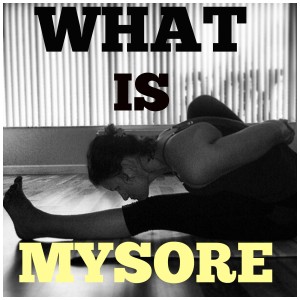What is Mysore?
Often I get asked this question and when I try to describe it to my students, I think it just makes them more confused and put off by the whole “Mysore Style of Yoga.â€
But what is it? How is it different from other yoga classes that I’ve taken?
First of all, Mysore class is the most basic way to teach yoga. In a regular studio yoga class, students are taught as a group. The teacher tells the students which poses they are going to do and all of the students do their best to do them, all at the same time. Since much of the yoga taught in the West today, evolved from group fitness classes, this format has remained the same as the evolution of yoga has moved into studios. This is why workshops are so important. Workshops break down a few postures and allow the students to work on them.
 But what if you could attend a yoga workshop every time you took a yoga class? What if the teacher taught you a specific group of postures that were meant especially for you? The teacher would demonstrate the poses that you are expected to perform and you would spend the class time working on those poses at your own pace, maybe only three to four poses at a time. You could practice for a half hour or up to two hours if you’d like, and you could come to class up to an hour after the class started. This is the Mysore method.
 People often get intimidated by the descriptions out there about Mysore classes. Their misconception is that they must already have the Ashtanga sequence memorized. But beginners to Ashtanga may find this better suits them. Maybe the beginner student cannot perform all of the sun salutations at one time. Maybe the student needs to rest. Maybe the student has an injury or an issue. Because of these things, the teacher may modify the practice to allow the student to take their time, or change the way they approach the postures to allow the body to heal.
 Some students have a lot of flexibility and very little strength, and the teacher can encourage the student to use their body to build up the strength they need. Other students may have health issues, be overweight or carry a long term injury. The teacher can guide the student to modify the postures so that they can still benefit from the practice without having to skip anything, utilizing the time that they have to maximize the benefits of the practice.
 Let me give you an example of a Mysore class with two new students. One has a lot of flexibility and strength, and is enthusiastic about learning yoga. The other student is often stressed, has an old knee injury and is very nervous about their first yoga class.  Both students come in and the teacher teaches them the first basic steps of Sun Salutation A.
The flexible student does it with ease and the teacher tells them to continue doing the Sun Salutations for a period of time. The second student is struggling, and can barely move from a forward bend into a plank position. The teacher will take the time to break down the sun salutation into bite size pieces so that this student can do what they can with the body they have. Once they feel comfortable with this sun salutation, the teacher will ask them to repeat it a few more times. If at that point the student has reached the point of exhaustion, on that day, that is where the lesson will end for that particular student. When they return to class the following day, they will learn a little more.
 Meanwhile, the flexible student may learn at a quicker pace, learning more postures in one day, but that does not mean that it is any less challenging. It is the job of the teacher to help each individual student to overcome their weaknesses and become stronger, mentally and physically.
 No matter your ability, fitness level, body type or physical capability, the Mysore practice can be suited to benefit anyone.
If you are interested in trying a Mysore class, Inspirit Yoga Studio has classes Monday, Wednesday & Friday from 6:30-8:30am. New students may come from 7-8am or earlier.Â
By: Maureen DinkinsÂ
